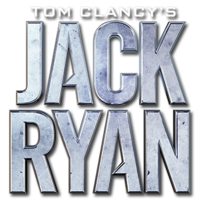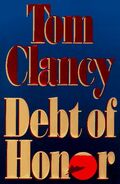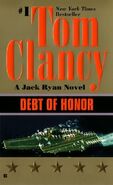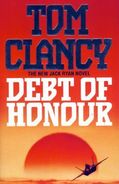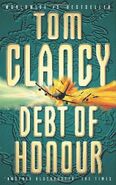Debt of Honor (1994) is a novel by Tom Clancy. In this installment, Jack Ryan has become the National Security Advisor when the Japanese government (controlled by a group of corporate tycoons known as the Zaibatsu) goes to war with the United States. One of the sub-plots in this novel (on occupying the [ Siberian "Northern Resource Area") would later form part of the main plot of Clancy's later novel The Bear and the Dragon.
Plot summary[]
In New York City, Japanese industrialist Raizo Yamata completes the purchase of a controlling interest in the Columbus Group of mutual funds from founder/Chairman George Winston, who is now in a position to retire. Yamata then flies to Saipan—where, during the Second World War, his parents had jumped off a cliff with many other Japanese when American troops stormed the island—to buy a large tract of land. On this land and on a mountainous tract in the Japanese Home Islands, Yamata plans to build hardened silos to hold Russian-made satellite-launching vehicles that had originally been designed as ICBM's, carrying payloads made to Yamata's specifications.
On Interstate 40 in Eastern Tennessee, a car accident involving a tractor-trailer and two Japanese-made "Cresta" cars results in the deaths of six people: two adults, two teenagers, a toddler, and an infant. The accident involves the failure of the fuel tanks in both Japanese cars, which causes a conflagration. It is revealed that the Japanese-made fuel tanks had been manufactured below proper safety standards, which caused them to fail. This stirs long-standing resentments stemming from Japan's protectionist trade policies, and trade negotiations with Japan grind to a halt.
As this plan is formulated, Jack Ryan, a private citizen after the events of The Sum of All Fears, is recruited as National Security Advisor by President Roger Durling. CIA officers John Clark and Domingo "Ding" Chavez are sent to Japan, covered as Russian reporters. Their mission is to reactivate a former KGB commercial spy network (codenamed THISTLE), pretending to be Russian spies for this purpose, in order to gain economic intelligence. The Japanese intelligence agents are not idle, either: they have manipulated one of the U.S. trade negotiators who admires Japan with promises of a lucrative consulting job after he resigns.
Increasing tensions with Japan cause Congress to pass the Trade Reform Act, enabling the United States to mirror the trade practices of the countries that it imports goods from. The bill is immediately used to replicate Japan's non-tariff barriers, and cuts off the export U.S. markets that Japan's economy depends upon: as U.S. inspectors carefully examine cars aboard incoming cargo ships, a line of ships waits offshore. Facing an economic crisis, the corporate oligarchs, presented as the true rulers of Japan, decide to take military action to safeguard the Japanese economy. Secretly supported by China and India, the plan involves curtailing the American presence in the Pacific in an effort to reestablish the Greater East Asia Co-Prosperity Sphere, which would include a later possible Chinese-Japanese invasion of Siberia to secure its extensive resources.
The Japanese plan has three major components. First, units of Japan's Self-Defense Forces will occupy the Mariana Islands, specifically the American military bases on Saipan and Guam. The invasion, conducted with commercial airliners, is virtually bloodless. Meanwhile, during a joint military exercise, Japanese ships "accidentally" launch torpedoes at two of the U.S. Navy’s Pacific Fleet aircraft carriers and two submarines at the conclusion of a joint U.S.-Japan naval exercise, destroying both submarines and crippling the carriers. This drastically reduces the U.S. capability to project power into the western Pacific.
An immediate retaliation is forestalled by the second element of the Japanese plan: an economic attack. Even as the military mission begins, the Japanese cabal engineers the collapse of the American stock market by hiring one of the main programmers of the exchange firm to insert a logic bomb into the system, exploiting flaws in the program-trading systems at major brokerage houses, then deletes all trade records and also attempts to murder the Federal chairman when one of their operatives shoves him into the path of a moving taxi, breaking his back . With a massive economic crisis on the horizon, and panic and chaos in America's homeland, it is hoped that America will be too distracted to quickly respond to Japan's military actions.
Japan immediately sues for a peaceful settlement, offering international talks and seemingly free elections in the Marianas, in attempt to stall and delay an American military response. Negotiators also secretly reveal to the Americans that Japan has obtained nuclear ballistic missile capability. The oligarchs, led by Raizo Yamata, believe that offers of negotiation and the nuclear deterrent, defended by a seemingly impregnable AWACS system, will cause America to concede Japan's advantage. With two of America's twelve carriers disabled, and the rest pinned down by international crises elsewhere (the result of Japan's covert allies' maneuvering), Ryan has few resources with which to defend American interests.
Although he is the National Security Adviser, seemingly focused on military issues, Ryan advises the President that the economic crisis must be dealt with first. After his wife Cathy Ryan casually remarks to him, "If it's not written down, it didn't happen," Ryan realizes that the deletion of trade records on the day of the crash (intended by the Japanese to cause further chaos and paralysis) could actually be an advantage. He engineers a "do-over", where that day of trading is ignored, and all assets are restored to their state at the start of business that day. George Winston's computer wizards help implement the plan. Accompanied by a Presidential address to the nation and behind-the-scenes bullying of investment bank CEOs and traders, the plan is a success: America's economy is restored with only minor disruption.
Ryan then turns his attention to the military confrontation. Through a series of special operations, Ryan first plans the elimination of Japan's AWACS system, through a series of "accidents" using widely dispersed American assets. Stationed near the end of a runway, Clark and Chavez blind the pilots with an extremely bright light, then watch the planes crash on landing. This is followed by B-2 Spirit attacks that destroy the Japanese nuclear-missile range when they destroy a dam, flooding the silos and killing all the technicians. Clark and Chavez, who have provided valuable intelligence and assisted in the destruction of the AWACS planes, now work along with U.S. special-operations assets to assassinate three-quarters of the Zaibatsu in the ruling clique, who are blown off the face of the earth by hellfire missiles in individual hits. They then set about rescuing the former, moderate Japanese Prime Minister who was kidnapped by Yamata's security and stashed in his penthouse, which they then infiltrate, killing most of the security personnel who are inside (while sparing one) with suppressed PSM pistols provided by the Russian Embassy. The Japanese spy in the U.S. diplomatic delegation is discovered and arrested. Ryan assigns his fighter-pilot friend, Admiral Robby Jackson, the job of liberating the Marianas, which is accomplished with little bloodshed while in a twist of dramatic irony, the commander of the sub which damaged the American vessels in the exercise is obliterated in the same circumstances. Cornered, the moderate Prime Minister bullies the current one to resign, quickly concedes defeat, arrests Yamata and the one surviving Zaibatsu, and accepts America's generous offer of status quo ante.
Throughout the book, President Durling has faced another, less important political crisis. His Vice President, Edward Kealty, has been accused of date rape using drugs on a former member of his staff. (This event had happened when Kealty was a Senator.) Although Kealty has sufficient political power to avoid conviction, he is forced to resign. With the crisis now over, President Durling nominates Jack Ryan to the Vice Presidency during a joint session of Congress on live television.
However, an embittered Japan Air Lines pilot who is driven mad by the deaths of his son (who is almost incinerated when his fighter lands on a unexploded munition) and brother-in-law (who is sunk) during the Pacific conflict, stabs his co pilot with a steak knife and commandeers a Boeing 747, flying it directly into the U.S. Capitol building during the proceedings. Nearly the entire presidential line of succession is eliminated, including the President, most of Congress, nearly all of the Cabinet, the Joint Chiefs of Staff, and all nine Supreme Court Justices. Ryan, who had just been confirmed as Vice President moments before, narrowly escapes the attack and is immediately sworn in as President. He begins his term of office in the immediate sequel, Executive Orders.
